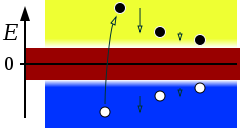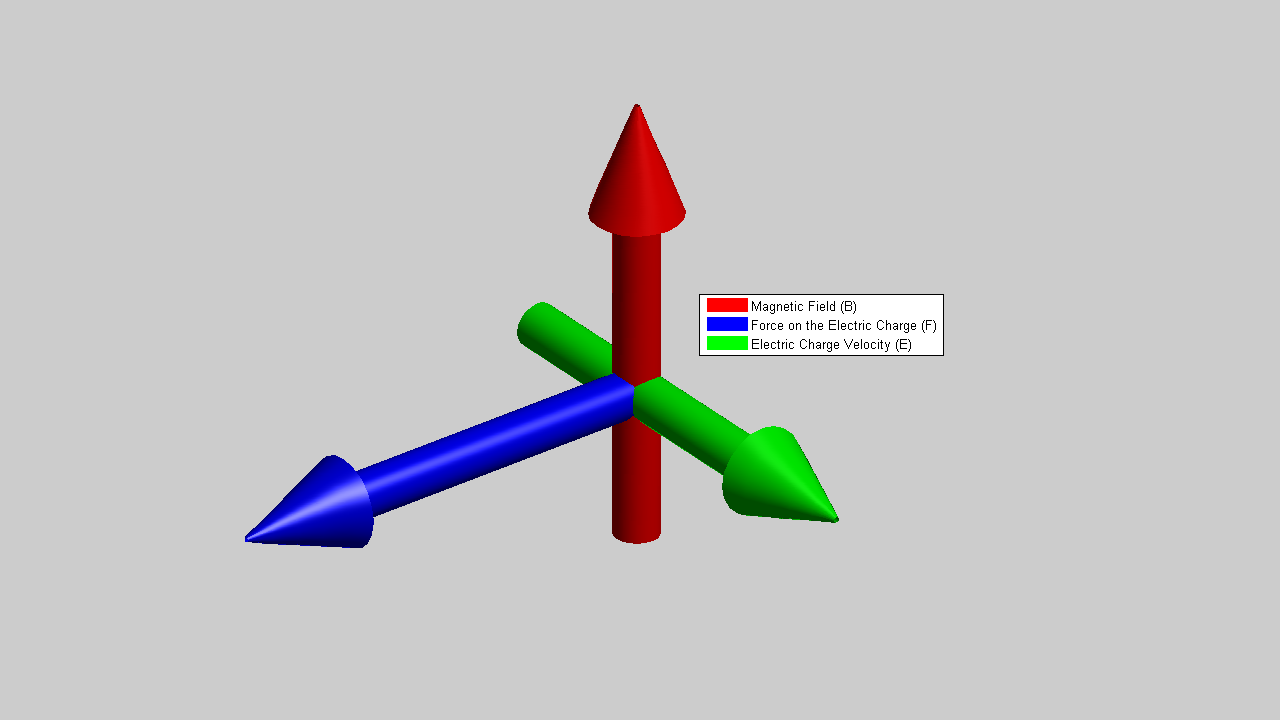Become a member of our Forum, and gain access to a lot more information!
I should first quote History, from Wikipedia:
The Dirac sea is a theoretical model of the vacuum as an infinite sea of particles with negative energy. It was first postulated by the British physicist Paul Dirac in 1930 to explain the anomalous negative-energy quantum states predicted by the Dirac equation for relativistic electrons. The positron, the antimatter counterpart of the electron, was originally conceived of as a hole in the Dirac sea, well before its experimental discovery in 1932.

Dirac sea for a massive particle.
Origins
The origins of the Dirac sea lie in the energy spectrum of the Dirac equation, an extension of the Schrödinger equation that is consistent with special relativity, that Dirac had formulated in 1928. Although the equation was extremely successful in describing electron dynamics, it possesses a rather peculiar feature: for each quantum state possessing a positive energy E, there is a corresponding state with energy -E. This is not a big difficulty when an isolated electron is considered, because its energy is conserved and negative-energy electrons may be left out. However, difficulties arise when effects of the electromagnetic field are considered, because a positive-energy electron would be able to shed energy by continuously emitting photons, a process that could continue without limit as the electron descends into lower and lower energy states. Real electrons clearly do not behave in this way.
Science categorises particles into three states, Positively Charged, Negatively Charged and Neutral, where a Proton has a net Positive Charge, the Electron a net Negative Charge and the Neutron a Neutral Charge. A Neutral Charge, being neither Positive or Negative.
Charged Particles are not considered "Electrical Energy" for the reason that they are not moving in time with Uniformity, even though, at the Atomic level, they are moving with massive velocities, rotating about their own axis, and orbiting the Nucleus, as a singular Atomic Structure, each Structure independently or randomly with respect to each other. Many billions of Atoms making up small pieces of Matter, which is a Mass. The Electron has a Mass, approximately 9.109×10−31 kilograms, or 5.489×10−4 atomic mass units, many subatomic particles do have a Mass in their own right, but not all.
The charge of the Electron is equivalent to the magnitude of the elementary charge (e) but bearing a negative sign. Since the value of the elementary charge is roughly 1.602 x 10-19 coulombs (C), then the charge of the Electron is -1.602 x 10-19 coulombs (C). The "Electrical Energy" unit, Ampere, measures 1 Ampere (A) at 6.24 * 1018 Electrons Per Second moving from Point A to Point B. This can be calculated: Q = I * t. Like Water can have a Current, a Mass of Water moving with Velocity, so can Charged Particles! Charged Particles moving with Velocity is also called a Current, which is the rate of the flow mentioned above, over Time, thus the term "Electrons Per Second".
All Particles that have a Charge also have a Magnetic Moment, meaning, the property of a magnet that interacts with an applied field to give a mechanical moment. At an Atomic scale, our Universe is massively active! It is alive in the true sense of the word!
An electrical insulator is a material whose internal electric charges do not flow freely; very little electric current will flow through it under the influence of an electric field.
A piece of Insulated Wire can be thought of as a Pipe, where Water can flow through the pipe. The Insulator being a boundary, where the Water is guided, a boundary, where the Water is bound, and can not pass this boundary unless this boundary is broken, for example, a hole in the Pipe.
The same is true for the Insulated Wire, Insulation is the boundary where Charged Particles can not pass unless the Insulation is broken. This simple plain fact is a very important fact to keep in mind at all times when studding "Electrical Energy" and the "Generation" of it.
As a result of the fore mentioned fact, we must always think of a piece of Insulated Wire as a wave guide, where the wave guide will have a specific wave length and this wave length will be determined by the length of the Insulated Wire and the properties that this Insulated Wire carry: Reactance XC and XL, Resistance and so on.
A resonance can be achieved at the Insulated Wires Wavelength, where the Insulated wire will act like an Antenna, and the Signal received will flow freely through this Insulated Wire at the specific Wavelength or at a harmonic of it. This will be the "Least" Resistance or Reflectance, where the "Electrical Energy" in the received Signal is not wasted, or reflected.
Normally an Antenna will be One Half (1/2) Wavelength, the optimal length for an Antenna, but Antenna's can be One Quater (1/4) Wavelength, but they must be grounded.
Resonance is a broad term and there can be different types of resonance. Electron Paramagnetic Resonance, RLC Resonance, Nuclear Magnetic Resonance and so on...
I want to give credit to the great Nikola Tesla, much if not all of our concepts on "Electrical Energy" are because of Nikola Tesla's work. I would like to quote:
Ere many generations pass, our machinery will be driven by a power obtainable at any point of the universe. This idea is not novel. Men have been led to it long ago by instinct or reason; it has been expressed in many ways, and in many places, in the history of old and new. We find it in the delightful myth of Antheus, who derives power from the earth; we find it among the subtle speculations of one of your splendid mathematicians and in many hints and statements of thinkers of the present time. Throughout space there is energy. Is this energy static or kinetic? If static our hopes are in vain; if kinetic — and this we know it is, for certain — then it is a mere question of time when men will succeed in attaching their machinery to the very wheelwork of nature.
Nikola Tesla "Experiments With Alternate Currents Of High Potential And High Frequency" (February 1892)
Electrical Energy is measured in Watts, or Watt Seconds, which is Joules Per Second. Watts or Watt Seconds is the sum of Voltage multiplied by Amperes, in a DC Case, more complex Math is required for Sinusoidal Waves, Volts * Amperes * Cos(theta), and more complex again for Square Waves.
A Voltage is measured in Volts and is the total Charge, Coulombs of Charge.
As mentioned above, 1 Ampere is 6.24 * 1018 Electrons Per Second moving from Point A to Point B.
Just as Water flows through a Pipe, Charged Particles Flow through an Insulated Wire, or in the case of an Electric "Generator" the Charged Particles, from the Atoms, Free Electrons, are Forced to flow, with a Velocity, through the Insulated Wire, due to the relationship explained in the Lorentz Force.
The Lorentz Force, after the Dutch physicist Hendrik A. Lorentz, is a very simple to understand Force. It is the Force exerted on a charged particle q moving with velocity v through an Electric E and Magnetic Field B. The entire Electromagnetic Force F on the charged particle is called the Lorentz Force and is given by F = qE + qv × B.

Similarly, a Magnetic Field B (Red Arrow) moving with Velocity V (Green Arrow), orthogonally or perpendicularly to a Conductor, then the Charged Particles, Free Electrons, will move in the direction of Force F (Blue Arrow) - This is called Electromagnetic Induction, discovered by Michael Faraday in 1831 - "Electrical Energy" Charged Particles, moving, inside an Insulated Wire, the Velocity of the Magnetic Field Invoking the separation of Charged Particles:
"Electrical Energy" is the Velocity of Charged Particles moving from Point A to Point B in Time, where each of these Charged Particles carry a Charge equal to that of the Electron: -1.602 x 10-19 - These Charged Particles can be guided by Electrically Neutral Materials called Insulators. "Electrical Energy" moves in the form of Waves of Potential called Electromagnetic Waves, and these waves bear all the known characteristics of the Electric and Magnetic Fields we know today. Science calls the study of such, Electrodynamics.
Matter as Fuel, the Separation of Charged Particles, Free Electrons, from Atoms, in Volume, all moving with a Uniform Velocity in a specific direction.